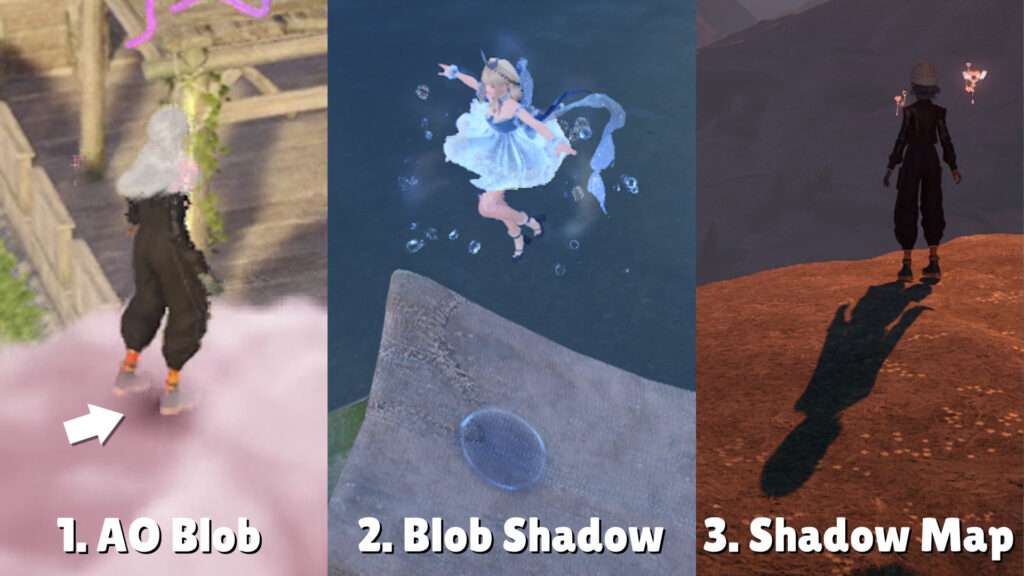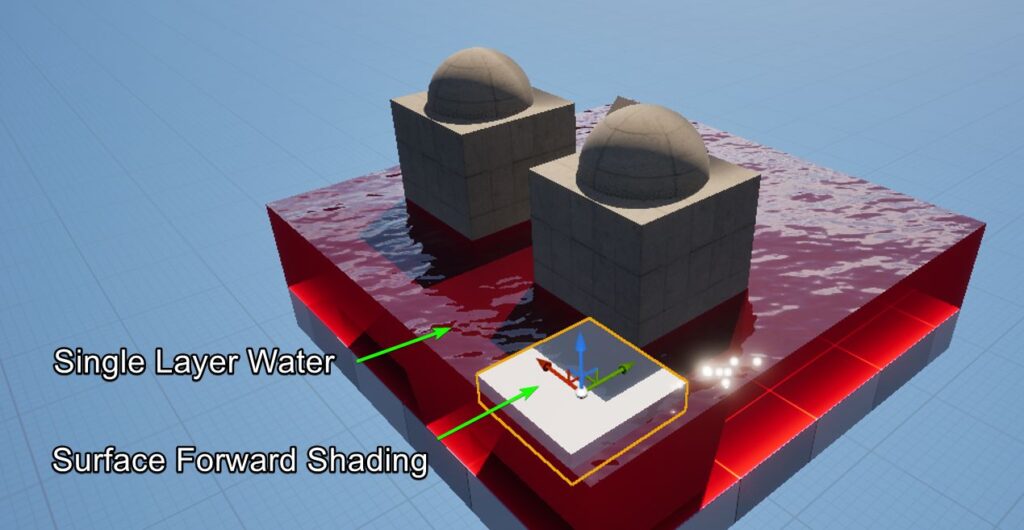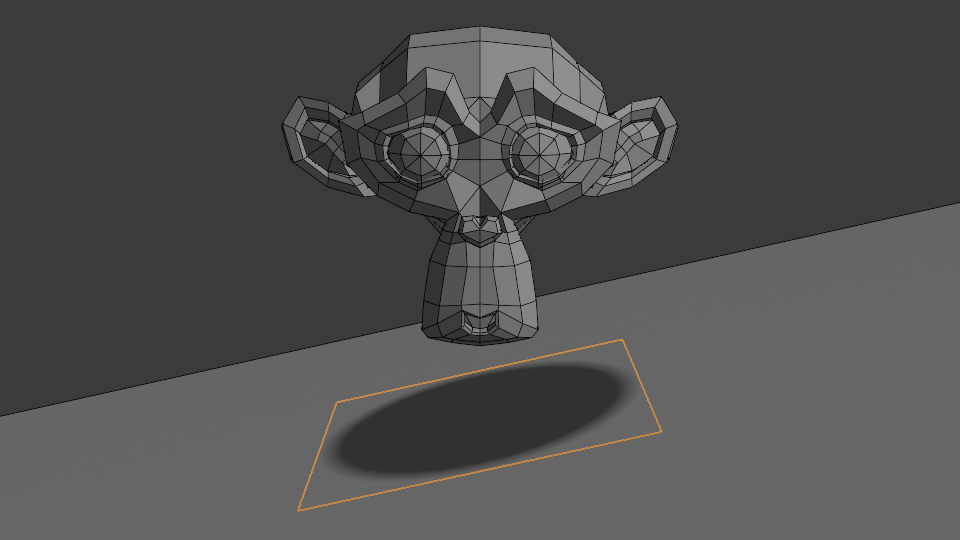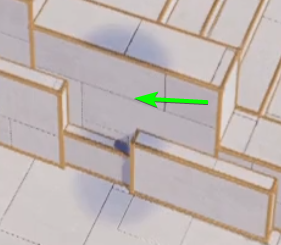Hey sunshine! 🌞
I f*ckd up. This is how I originally planned this article: It should be short, contain 1-2 videos and express the following:
“Look! In Infinity Nikki the character has a “real” shadow, but the developers fade it out while jumping to make space for a blob shadow (which helps to navigate while jumping/gliding).”
But the more I looked into the subject, the more observations I made, the more people got involved (to give me advice), and the article grew longer and longer. I’m sorry.
Unfortunately, none of the usual profilers attaches to the game (I tried Renderdoc, Nsight & GPA). So I can only assume, and there’s no proof of anything!
💘💘💘 Huge thanks to Nemi, Ben Golus & Froyok for helping with this article. 💘💘💘
Table of Content
Shadow Map | Blob Shadow | Blob vs Decal | Ambient Occlusion | Bonus Observations | Summary | Bonus Links
Overview
I have the impression, that there are 3 different types of shadows at play:
- Ambient Occlusion Blob: Subtle. Grounds characters in the world.
- Blob Shadow + Blue Ring: Appears while jumping/gliding. Serves as landing guide.
- Realistic Shadow: Made with shadow mapping. Fades out while jumping/gliding.

Shadow Map: Selective Fading
As you saw in the first video, while jumping, a blob shadow is fading in, while the “realistic” shadow fades out. This avoids having two shadows (realistic shadow map & blob shadow) at the same time. BUT, for some reason, it’s still visible on other characters!
Why is the shadow still visible on NPCs?
There might be a separate shadow pass just for self-shadowing of characters. This pass seems to contain Nikki’s shadow (next to all characters) and is not modified at all. A custom technology for the self-shadowing was mentioned in their behind the scenes article:
“For character lighting, we developed high-quality shadows specifically for characters to achieve detailed self-shadowing.”
How can they make Nikki’s shadow fade independently of all other shadows?
Nikki’s shadow seems to render in a separate shadow pass, which allows rendering it with different translucency.
In summary, if the theory is correct, we have three shadow passes: One for all objects and NPCs, one for Nikki (can fade in/out) and one for character self-shadowing including Nikki and all NPCs.
A crude version of this (using dithering for the fading) is possible in Unreal by using the Shadow Pass Switch-Node. Here is an example where I fade a selected cube:
In both cases, dithering is at work. With classic low resolution shadow maps, it isn’t as obvious (because everything looks a bit blurrier), but with the virtual shadow maps (which allow for sharper shadows), we can see the dithering noise very clearly.
Just for your information, this is the material of the center cube:

A capture of the frame shows how it works. For calculating a shadow map, we need a depth buffer that contains the scene from the camera’s point of view and another one from the light source’s point of view (they get compared with code magic to give us the shadow information). The first one looks like expected (it contains the floor and our three boxes). The latter, on the other hand, contains our center box as a dithered version and thus generates the dithered shadow:
FYI: Found this article The Case of the Disappearing Shadow: Gradual Shadow Fading about selective fading by using a separate depth buffer.
History Lesson
Older games didn’t have this “double shadow” problem because shadow mapping was too expensive back then. So, in Super Mario 64 there is just a blob shadow. I really like that it gets smaller when Mario is further away from the ground – nice detail! 👍
Jump & Run games usually rely on having such a blob shadow to show the players where they land. As soon as “real” shadows (shadow mapping) are added, developers have to decide how to deal with the “double shadow” issue.
As already mentioned, in Infinity Nikki, the “real” shadow is replaced by a blob shadow while jumping. But here are two more solutions:
💡 Alternative Solution 1: Top-Down Shadow
In Super Mario Odyssey, Mario’s shadow is different from that of the NPCs. While theirs is projected from the sun direction, Mario’s is always projected from the top, and no extra blob shadow is needed (according to this post, Mario uses a stencil shadow):

💡 Alternative Solution 2: Just show both
Yooka-Laylee (and this Raytracing version from Super Mario 64) simply allows both shadows to exist at the same time:
By the way, Yooka-Laylee has a nice trick on defining when the blob shadow should become visible! Instead of a distance-based calculation between character and floor, they put a decal projection several centimeters below the feet. It’s always there, like this edge case reveals:
As soon as the player jumps, the decal projection will be raised above the ground and suddenly draw a pleasant blob on the floor.
Speaking of…
Blob Shadow
Classic blob shadows are simple quads with a radial gradient texture. They are placed close to the floor and align to it.
Unfortunately, when the ground is uneven, the illusion breaks quickly. Here we see how the quad penetrates the surface before getting re-aligned:
Keep this artifact in mind! We’ll see it later in Infinity Nikki as well when we talk about blob shadows on water!
A more modern approach would be to project a texture onto the floor (as Yooka-Laylee does it) instead of using a floating plane. This is usually called “decal”:
You may think, that such a projected decal is way cooler than a stinky old plane. But there is a case where projections usually don’t work: Water! 💧
Blob Shadow vs Decal
A plane can easily be placed above water. Here you can observe that the blob shadow switches from being below or above water, depending on Mario’s vertical position:
Yooka-Laylee on the other hand, uses a projected decal for the drop shadow. Problem: It’s not working on translucent surfaces!
Look how the drop shadow is only rendered below the water surface and becomes almost invisible:
That’s a common issue, since the decal projection relies on the depth buffer and water doesn’t get written into it.
While a plane may be a better option in this case, it comes with another disadvantage (apart from intersecting with uneven terrain): It is a bit “jumpy” when moving along an environment with height differences.
Mario’s shadow plane suddenly changes its height position. It’s only visible either on the floor or the ceiling:
A projection has the advantage, that it can be seen at different heights at the same time. Here, for example, it’s visible on the floor and the platform:
But even here, the lower shadow suddenly disappears! I assume that when Peaches pivot point is above the platform, the projection distance is updated and now too short to reach the floor. This might be a workaround to avoid seeing the shadow on the platform and the floor at all times.
This behavior can be observed in Yooka-Laylee. Here the blob shadow is projected on the planks and the floor below:
Another potential small visual issue with projections: they may result in very long shadows on verticals surfaces:
We’ll talk later about a method to prevent this from happening.
Let’s go back to Nikki. How did they make the blob shadow? Is it a plane or a decal?
I assume: It’s two planes and one decal! *mic drop*
While gliding, it’s easy to observe that there is a plane that aligns to the underlaying surface. At least the blue ring is a plane:
What about the blob shadow? Well…remember the Mario 64 example, where the plane would be only visible at one height position at a time?
Here, on the other hand, we can see that the shadow is visible at the floor and the tent for some time (like in the example with Peaches platform):
And here it’s even more obvious, that our drop shadow is projected at different heights at the same time. So we can assume: The blob shadow is a decal projection!
It is an interesting detail, that the projection on the floor fades out with a small delay in comparison to the others … no idea what’s going on there.
“But Simon, why then we don’t see this strong vertical shadow like in the example with Peach?”
I think they just mask the projection based on the normal orientation of the environment. Here is a demo (and I made a tutorial):
“But Simon, you said decals can’t be projected on the water surface! Why do we see it in Nikki?!”
This is where the second plane comes into play! I think they always place a blob shadow plane slightly above the water surface in addition to the decal projection for the blob shadow and the blue ring plane. Here you can see all three elements working together:
Although, I would expect to see the blob shadow projection on the floor below the water like in Yooka-Laylee… no idea why it’s not appearing. Maybe the projection distance is limited so that it never goes deeper than the water surface?
Here is a collection of examples where we can observe two more behaviors:
- The “water plane” always stays at the water height and does not align to any surface below, which makes it sometimes intersect with the environment (like the Mario 64 example from above).
- Sometimes, we can see the projected blob shadow and the surface-aligned blue circle on top of the intersecting “water plane”:
Thought we’re done? No! Turns out, in caves, Nikki’s “real” shadow is not faded away (and maybe they are using capsule shadows since they don’t need so much accuracy?):
Another detail: The “water plane”, which is usually seen above the water, suddenly disappears while jumping from one side to the other – but does not reappear, when jumping back. (o.O)
Quite a lot of food for thought, isn’t it? Did you expect such a long part about simple blob shadows? I certainly did not ! :)
Now that we thought a lot about the blob shadow, let’s have a short look at the subtle ambient occlusion.
Ambient Occlusion: Decal or Plane?
I think that the AO in Infinity Nikki is another decal projection because when standing on an edge, you can see it reach 1 meter downward “into the ground”:
Here is another example. I hope you can see well how the AO decal is projected onto the ground and draws a nice subtle AO blob:
That’s basically all I wanted to share, but while recording all those videos, I made some more observations.
Bonus Observations
Shadow on Water
I’m always delighted to see when games render shadows on the water surface. It’s not well visible in this video, but yes, the stone also casts shadows on the water surface:
There are methods to replicate this in Unreal. For example, a translucent material with lighting mode Surface Forward Shading or the Single Layer Water shading model:

Also, when you create a new Unreal 5.5 project with a quality preset set to maximum, it should work with all other material lighting modes as well! For some reason, I didn’t get this working in my project, which I created in 4.x, but with a fresh 5.5 project it worked out of the box (because the directional light has Cast Volumentric Shadow enabled by default):
Important note from the docs: “r.TranslucencyLightingVolumeDim, which defaults to 64. Raising this by a factor of 2 increases the cost to light volume by a factor of 8.”
Item Shadows
Items can have unique shadows that do not belong to the shadow map. We can notice this because:
- Item shadows always are always cast from above, while environment shadows are cast from the sun direction.
- Item shadows darken already shadowed areas even more.
The item shadows use decal projections and planes (to show up on water). Here is an example for a projection:
And here is an example where we can see how a plane is used as a shadow on the water (and how it intersects with the incoming barrel):
Interesting detail: When items are created “on the fly” they do not have shadows:
And this might be the proof that the item shadows are just rotating decals with pre-made textures, because here we can clearly see, that the mesh shape does not match the shadow (Bonus: We can see a soft fade in when Nikki comes closer to the decal).
In the video above, several decals seem to overlap each other, and that’s why they appear so dark. Here is another capture of how decals overlap sometimes:

What is this?
Here, I do not have ANY idea what’s happening. For some reason, when you walk below such a launch pad, there appears a blob shadow above Nikki!?
Here is a closer look:
What is this?! Why is it appearing above Nikki?!
Summary
Again, everything in this article is guesswork! Here is a little recap:
🌞 The game uses shadow maps for beauty
- One pass for everything except Nikki
- One pass for Nikki (to fade out her shadow independently while jumping/gliding) – except while being in a cave!
- One pass for character self-shadowing (that’s why we see Nikki’s shadow on other characters while jumping/gliding)
🕊️ The game uses a blob shadow to help with navigation while gliding
This blob shadow consists of:
- Two decal projections (blob & ambient occlusion)
- The blob shadow seems to be masked by the surface normal
- Two planes (blue circle & blob shadow)
- The blue circle aligns to the surface below
- The blob is always placed slightly above the water and does not align to any surface
⭐ Items may have shadows as well (except the items spawn on the fly)
This shadow consists of:
- A (sometimes rotating) decal projection using pre-made textures
- A plane using a pre-made texture for showing the shadow above the water surface
Thanks for reading the article! If you have more theories about the rendering techniques, let me know!
Simon
Bonus Links
Infinity Nikki is a fantastic game, very optimized and the developers extended the Unreal Engine with amazing custom tech like Order-Independent Transparency (OIT), custom particle collision, custom fur and multi layer cloth collision. Read more about it in this official Epic article.
If you can’t hear enough about shadows, there is this awesome article explaining different old school shadow rendering techniques.
Here is a great paper about the difference in perception of blob shadow vs shadow map.

You want even more old school? Then check out my old article about how “transparent” shadows were done in 1987.






